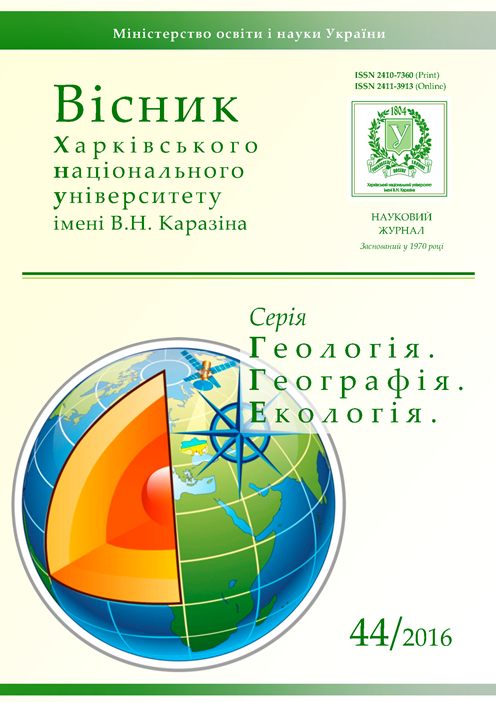Використання методики екологічного сліду у конструктивно-географічному дослідженні
Анотація
У статті визначено аспекти використання методики екологічного сліду у конструктивно-географічному дослідженні задля оцінювання навантаження на навколишнє середовище в регіонах України. Проаналізовано, яким чином методологія враховує комплексність впливів на навколишнє середовище, які просторові властивості можуть бути визначені, а також яким чином екологічний слід може бути використаний у процесі прийняття рішень.
Дослідження складається з трьох етапів: 1) аналіз переваг та недоліків використання методології екологічного сліду; 2) розрахунок величин екологічного сліду та біологічної ємності території регіонів у 2000-2012 рр. та визначення тенденцій; 3) аналіз корисності методології для прийняття рішень.
У результаті, було визначено величини екологічного сліду та біологічної ємності для жителів українських регіонів, тренди зміни цих величин та обмеження щодо використання методики.
Завантаження
Посилання
2. Wackernagel, M., Rees, W. (1998). Our Ecological Footprint: Reducing Human Impact on the Earth. New Society Publishers, 176.
3. Lin, D., Wackernagel, M., Galli, A., Kelly, R. (2015). Ecological Footprint: Informative and evolving – A response to van den Bergh and Grazi (2014). Ecological Indicators, 58, 464-468. doi: http://dx.doi.org/10.1016/j.ecolind.2015.05.001
4. Van den Bergh, J. C. J. M., Verbruggen, H. (1999). Spatial sustainability, trade and indicators: an evaluation of the ‘ecological footprint’. Ecological Economics, 29(1), 61-72. doi: http://dx.doi.org/10.1016/S0921-8009(99)00032-4
5. Van den Bergh, J. C. J. M., Grazi, F. (2015). Reply to the first systematic response by the Global Footprint Network to criticism: A real debate finally? Ecological Indicators, 58, 458-463. doi: http://dx.doi.org/10.1016/j.ecolind.2015.05.007
6. Galli, A. (2015). On the rationale and policy usefulness of Ecological Footprint Accounting: The case of Morocco. Environmental Science & Policy, 48, 210-224. doi: http://dx.doi.org/10.1016/j.envsci.2015.01.008
7. Lambrechts, W., Mulà, I., Ceulemans, K., Molderez, I., Gaeremynck, V. (2013). The integration of competences for sustainable development in higher education: an analysis of bachelor programs in management. Journal of Cleaner Production, 48, 65-73. doi: http://dx.doi.org/10.1016/j.jclepro.2011.12.034
8. Gryshchenko, N.V. (2014). Environmental management education: international traditions and Ukrainian experience. Problems of Continuous Geographical Education and Cartography, 20, 148–153.
9. Loiseau, E., Junqua, G., Roux, P., Bellon-Maurel, V. (2012). Environmental assessment of a territory: An overview of existing tools and methods. Journal of Environmental Management, 112(0), 213-225. doi: http://dx.doi.org/10.1016/j.jenvman.2012.07.024
10. Gryshchenko, N. V. (2014). Otsínyuvannya vídnosin lyudini í navkolishn'ogo seredovishcha v Ukraí̈ní kríz' prizmu yekologíchnogo slídu [Human-environmental relationship in Ukraine through the prism of ecological footprint]. Ukrainian Geographical Journal, 2, 44-50. doi: http://dx.doi.org/10.15407/ugz2014.02.044
11. Grishchenko, N. V. (2014). Otsenka nagruzki na okruzhayushchuyu sredu v Ukraine na regional'nom urovne metodom ekologicheskogo futprinta [Environmental impact assessment in Ukraine at regional level using eco-logical footprint method]. Geopolitics and Ecodynamixs of Regions, 2 (10), 489-493.
12. The State Statistics Service of Ukraine. Available at : http://www.ukrstat.gov.ua
13. Derzhavna sluzhba Ukraí̈ni z pitan' geodezíí̈, kartografíí̈ ta kadastru [the State Service of Ukraine for Geodesy, Cartography and Cadastre]. Available at : http://land.gov.ua
14. Toth, G., Szigeti, C. (2016). The historical ecological footprint: From over-population to over-consumption. Ecological Indicators, 60, 283-291. doi: http://dx.doi.org/10.1016/j.ecolind.2015.06.040
15. Van Vuuren, D. P., Smeets, E. M. W. (2000). Ecological footprints of Benin, Bhutan, Costa Rica and the Netherlands. Ecological Economics, 34(1), 115-130. doi: http://dx.doi.org/10.1016/S0921-8009(00)00155-5
16. Bakkes, J. A. (1994). An Overview of Environmental Indicators: State of the Art and Perspectives: Environmental Assessment Sub-Programme, UNEP/Earthprint, 72.
17. Gryshchenko, N.V. (2015). Constructive-geographical aspects of anthropogenic environmental impact assessment in Ukrainian regions in 2000-2012. "Economics for Ecology" - ISCS'2015. Proceeding of 21st International Scientific Conference. Sumy (Ukraine), 38-40.
18. Global Footprint Network. Country Trends: Ukraine 2015. Available at : http://www.footprintnetwork.org/en/index.php/GFN/page/trends/ukraine/
19. Niccolucci, V., Tiezzi, E., Pulselli, F. M., Capineri, C. (2012). Biocapacity vs Ecological Footprint of world regions: A geopolitical interpretation. Ecological Indicators, 16, 23-30. doi: http://dx.doi.org/10.1016/j.ecolind.2011.09.002
20. Intended Nationally-Determined Contribution (INDC) of Ukraine to a New Global Climate Agreement. Available at : http://www4.unfccc.int/submissions/INDC/Published%20Documents/Ukraine/1/150930_Ukraine_INDC.pdf





